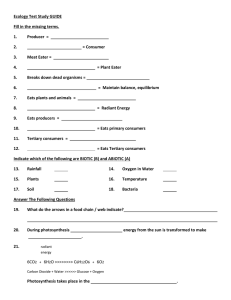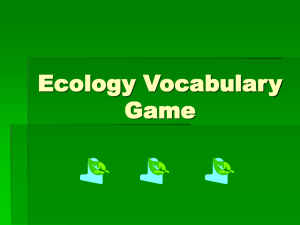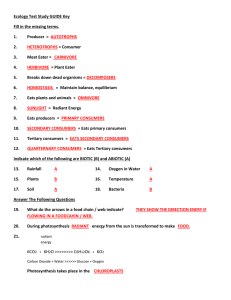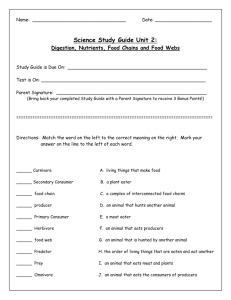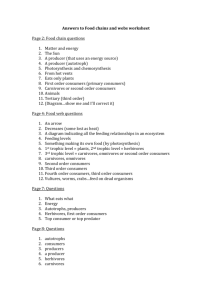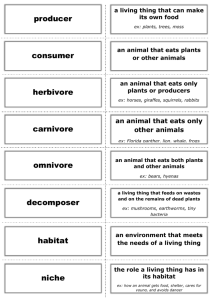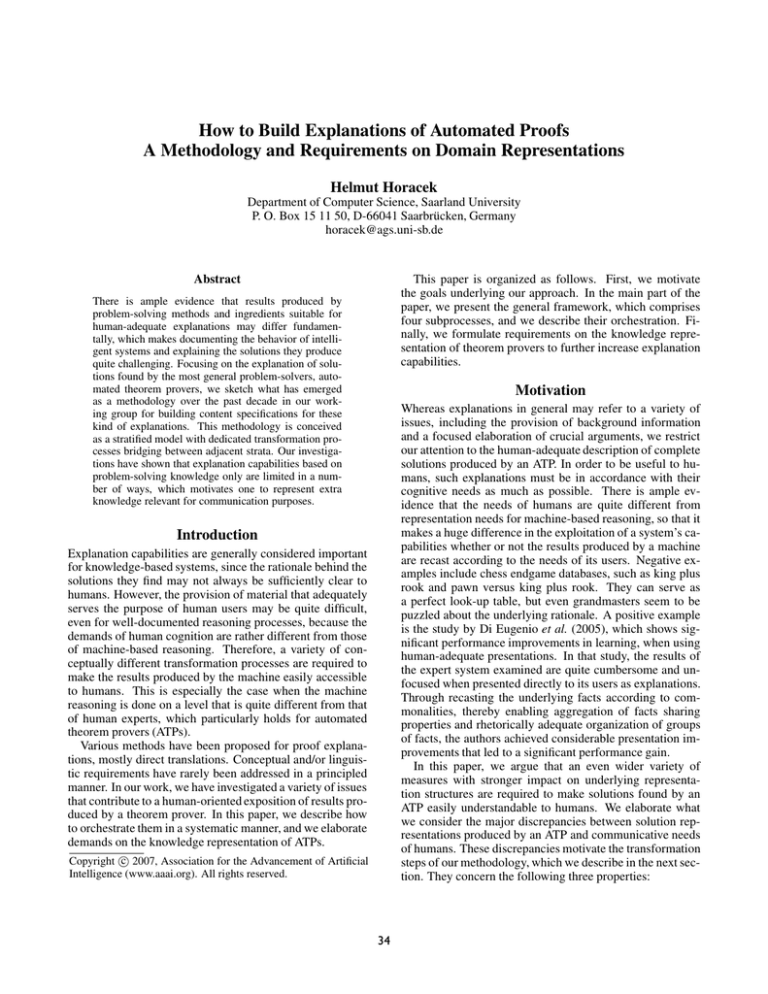
How to Build Explanations of Automated Proofs
A Methodology and Requirements on Domain Representations
Helmut Horacek
Department of Computer Science, Saarland University
P. O. Box 15 11 50, D-66041 Saarbrücken, Germany
horacek@ags.uni-sb.de
This paper is organized as follows. First, we motivate
the goals underlying our approach. In the main part of the
paper, we present the general framework, which comprises
four subprocesses, and we describe their orchestration. Finally, we formulate requirements on the knowledge representation of theorem provers to further increase explanation
capabilities.
Abstract
There is ample evidence that results produced by
problem-solving methods and ingredients suitable for
human-adequate explanations may differ fundamentally, which makes documenting the behavior of intelligent systems and explaining the solutions they produce
quite challenging. Focusing on the explanation of solutions found by the most general problem-solvers, automated theorem provers, we sketch what has emerged
as a methodology over the past decade in our working group for building content specifications for these
kind of explanations. This methodology is conceived
as a stratified model with dedicated transformation processes bridging between adjacent strata. Our investigations have shown that explanation capabilities based on
problem-solving knowledge only are limited in a number of ways, which motivates one to represent extra
knowledge relevant for communication purposes.
Motivation
Whereas explanations in general may refer to a variety of
issues, including the provision of background information
and a focused elaboration of crucial arguments, we restrict
our attention to the human-adequate description of complete
solutions produced by an ATP. In order to be useful to humans, such explanations must be in accordance with their
cognitive needs as much as possible. There is ample evidence that the needs of humans are quite different from
representation needs for machine-based reasoning, so that it
makes a huge difference in the exploitation of a system’s capabilities whether or not the results produced by a machine
are recast according to the needs of its users. Negative examples include chess endgame databases, such as king plus
rook and pawn versus king plus rook. They can serve as
a perfect look-up table, but even grandmasters seem to be
puzzled about the underlying rationale. A positive example
is the study by Di Eugenio et al. (2005), which shows significant performance improvements in learning, when using
human-adequate presentations. In that study, the results of
the expert system examined are quite cumbersome and unfocused when presented directly to its users as explanations.
Through recasting the underlying facts according to commonalities, thereby enabling aggregation of facts sharing
properties and rhetorically adequate organization of groups
of facts, the authors achieved considerable presentation improvements that led to a significant performance gain.
In this paper, we argue that an even wider variety of
measures with stronger impact on underlying representation structures are required to make solutions found by an
ATP easily understandable to humans. We elaborate what
we consider the major discrepancies between solution representations produced by an ATP and communicative needs
of humans. These discrepancies motivate the transformation
steps of our methodology, which we describe in the next section. They concern the following three properties:
Introduction
Explanation capabilities are generally considered important
for knowledge-based systems, since the rationale behind the
solutions they find may not always be sufficiently clear to
humans. However, the provision of material that adequately
serves the purpose of human users may be quite difficult,
even for well-documented reasoning processes, because the
demands of human cognition are rather different from those
of machine-based reasoning. Therefore, a variety of conceptually different transformation processes are required to
make the results produced by the machine easily accessible
to humans. This is especially the case when the machine
reasoning is done on a level that is quite different from that
of human experts, which particularly holds for automated
theorem provers (ATPs).
Various methods have been proposed for proof explanations, mostly direct translations. Conceptual and/or linguistic requirements have rarely been addressed in a principled
manner. In our work, we have investigated a variety of issues
that contribute to a human-oriented exposition of results produced by a theorem prover. In this paper, we describe how
to orchestrate them in a systematic manner, and we elaborate
demands on the knowledge representation of ATPs.
c 2007, Association for the Advancement of Artificial
Copyright Intelligence (www.aaai.org). All rights reserved.
34
Figure 2: The definition of the Steamroller problem
Figure 1: Architecture for building content specifications
Axioms:
Problem−solving
calculus
1. Wolves, foxes, birds, caterpillars, and snails are animals,
and there are some of each of them.
2. Also there are some grains, and grains are plants.
3. Every animal either likes to eat all plants or all animals
much smaller than itself that like to eat some plants.
4. Caterpillars and snails are much smaller than birds, which
are much smaller than foxes, which in turn are much
smaller than wolves.
5. Wolves do not like to eat foxes and grains.
6. Birds like to eat caterpillars, but not snails.
7. Caterpillars and snails like to eat some plants.
Calculus Transformation
Human−oriented
calculus
Condensation/Expansion
Mixed
granularity levels
Omission of specifications
Selective
inference steps
Theorem:
8. Therefore, there is an animal that likes to eat a graineating animal.
Reorganization
Recast
reasoning chains
• Technical versus Conceptual/linguistic references
References to subarguments in a reasoning structure, as
virtually all internal references in computers, are realized
in a straightforward manner by some sort of pointers. Obviously, this measure is inaccessible to humans, and it is
naturally replaced by some sort of naming reference to
pieces of domain knowledge that make up an argument.
The more these references are elaborated, and the more
background knowledge is taken into account for their realization, the more easily understood are explanations in
which such references are embedded.
• Uniformity versus Diversification
Whereas reasoning within machines works best on a uniform level of representation, the resolution calculus being the most prominent example, humans frequently mix
up levels of representation in their argumentation to meet
the expected skills in understanding. Within the calculus of Natural Deduction, for instance, cognitively difficult reasoning patterns lead to incorrect conclusions more
often than simple patterns. In fact, psychological experiments have shown substantial differences among the ease
of understanding deductive syllogisms: approx. 90% correct inferences for modus ponens, as opposed to around
50% only for modus tollens and disjunction, according to
Johnson-Laird and Byrne (1990). Thus, inferences following cognitively difficult patterns need more detailed
descriptions to be understood properly (Walker 1996).
• Explicitness versus Selectivity
For machine-based reasoning, all pieces of information
for drawing inferences must be represented explicitly. For
humans, presentations in this form are frequently perceived as redundant and boring, so that people tend to forget the essential information found between the descriptions perceived as redundant. In contrast, humans prefer
arguments containing only some part of the underlying
reasoning pattern (“modus brevis” according to Sadock
(1977)), even with intermediate arguments not mentioned
at all, when they can be recovered on the basis of contextual expectations (Thüring and Wender 1985). Another
aspect is the use of presentation means that exploit commonalities across arguments, similar to the approach by
Di Eugenio et al. (2005), provided compact natural language forms to express common parts are available.
In the following, we will describe techniques for building the content specifications of explanations that take into
account the discrepancies outlined above, so that representation differences are bridged as well as possible.
Building the Content of Explanations
In the scope of this paper, we only address methods for
building the content of explanations, not techniques for expressing these specification in natural language. In principle, presentations based on the content representation of
automated proofs could be realized in full-fledged natural
language, in some pattern-based pseudo natural language or
even in terms of some sort of graphical and textual display.
We propose a stratified process to tailor the content of
explanations originating from problem solving results produced by an ATP. The architecture is depicted in Figure 1,
with individual strata enclosed by ellipses. As a running example, we use the Steamroller problem (Stickel 1986), see
the definition in Figure 2. In a nutshell, the proof runs along
the following lines: through applying the central axiom (3.)
three times, it is first derived that birds eat grain, then that
foxes do not eat grain and, finally, that foxes eat the smaller
grain-eating birds, the last being the witness needed to prove
the theorem (8.) to be true.
35
Figure 3: Expanding an Assertion Level step in the solution to the Steamroller problem to the Partial Assertion Level
1.
2.
Eats(w, g) ∨ ((Eats(f, g) ∧ (f < w)) → Eats(w, f ))
¬Eats(f, g)
¬Eats(w, g)
¬Eats(w, f )
f <w
↓
Eats(w, g) ∨ ((Eats(f, g) ∧ (f < w)) → Eats(w, f )) ¬Eats(w, g)
DE
(Eats(f, g) ∧ (f < w)) → Eats(w, f )
¬Eats(w, f )
MT
¬Eats(f, g) ∨ ¬(f < w)
¬Eats(f, g)
Reaching a Human-Oriented Reasoning Level
Assertion
f <w
DE
man argumentation. However, the Assertion Level falls short
for cases of cognitively difficult inference patterns, since
presentations at this level of granularity do not adequately
support understanding of the underlying reasoning. For example, applying transitivity in reverse direction involves a
modus tollens embedded in a single Assertion Level step, so
that it is hard to understand the inference presented in this
compact form. To handle such problematic situations, we
have proposed the Partial Assertion Level (Horacek 1999).
It is mostly an Assertion Level representation, but inference steps containing cognitively difficult Natural Deduction steps are expanded to a composition of these more finegrained inference steps. Since building representations at
this level is a variant of building representations at the Assertion Level, this transformation step in the overall process
can also be considered as solved.
In the Steamroller problem, performing the transformation from the Assertion Level to the Partial Assertion Level
is quite essential. It applies to three involved Assertion Level
steps, which constitute the major subproofs of the whole
problem: 1) birds eat grain, 2) foxes do not eat grain, and
3) foxes eat birds, on the basis of 1) and 2). In Figure 3, we
show the expansion of subproof 2): The involved Assertion
Level step is decomposed into two disjunction eliminations
(DE), surrounding a modus tollens (MT). The variables f ,
g, and w stand for fox, grain, and wolf, respectively.
In natural language terms, using references to meat eater
and plant eater (see the overnext subsection), the two representation variants can be paraphrased by:
In this phase, representations in a machine-oriented calculus
– typically resolution graphs – are transduced into a system
of human-oriented inferences – mostly based on Natural Deduction. In principle, a resolution proof itself could also be
subject to an explanation, but the conceptual means to tailor
its content according to humans needs would be limited. An
important representation form based on Natural Deduction
is the Assertion Level (Huang 1994), which constitutes a representation on the level of domain axioms. It is an abstraction based on Natural Deduction – one Assertion Level step
comprises several Natural Deduction steps. There exist a
variety of procedures that build Natural Deduction representations on the basis of resolution proofs. Moreover, Assertion Level representations can be built out of Natural Deduction proofs and even directly out of resolution proofs (Meier
2000). Hence, accomplishing this transformation step in the
overall process can be considered as solved.
For the Steamroller problem, the proof graph obtained by
applying the theorem prover OTTER (McCune 1994) and
transforming the result to the Assertion Level consists of 51
nodes. The proof presentation system PROVERB (Huang
and Fiedler 1997) produces a full page of text from this proof
graph, which we believe is pretty much comparable in length
to what other systems would do. From the perspective of human needs, the presented content is quite disappointing. On
the one hand, it is too verbose, because it contains many
trivially inferable reasoning steps, mostly categorical generalizations and instantiations. On the other hand, it is too
compact in some essential parts, since the Assertion Level
representations do not expose cognitively difficult inference
steps in detail. In the following two subsections, we illustrate how these problems are handled by our methodology.
1. From applying axiom 3 to the wolf and the fox, it follows
that foxes are not plant eaters, since wolves are not plant
eaters, are bigger than foxes, and do not eat foxes.
2. From applying axiom 3 to the wolf and the fox, it follows
that wolves are meat eaters, since they are not plant eaters.
Moreover, foxes are not plant eaters or not smaller than
wolves, since wolves do not eat foxes. Since foxes are not
smaller than wolves, they cannot be plant eaters.
Condensation or Expansion of Inference Steps
This is the first transformation step that takes into account
human needs for diversification of presentation contents.
Depending on whether the input representation at this stage
is fine-grained (Natural Deduction) or coarse-grained (Assertion Level), applying condensation or expansion operations is advisable. By and large, Natural Deduction is considered too detailed in general, while the Assertion Level is
a good approximation of the representations underlying hu-
Whereas the underlying reasoning in the more compact
variant requires considerable afterthought to be understood
properly, if possible at all, the second variant exposes the
underlying reasoning steps explicitly in detail, so that the
whole subproof can be followed rather easily.
36
Figure 5: Successively pruning portions of a proof tree
Figure 4: A rule that prunes portions of the proof tree
Aware − of (U ser, Axiom(T ))
∧
Able − Inf er(U ser, P remises(T ), Conclusion(T ))
→
Omit < References to Axiom T in the inference step >
0<1
1<a
T ransitivity(<)
0<a
T richotomy(<, =)
0 = a
Omitting
↓
a trivial premise
1 < a T ransitivity(<)
0<a
T richotomy(<, =)
0 = a
Omission of Inferable Inference Components
In this transition phase, adopting selectivity on the fully explicit proof representation is addressed. This measure aims
at building “truncated” arguments, thereby going beyond
Sadock’s (1977) “modus brevis” forms. To present an argument, which is mostly the application of a domain axiom
in modus ponens, not only the instantiated form of the axiom
is omitted, which is a simple measure used in many methods. In addition to that, appropriate applications of three
categories of omissions contribute to the incremental compactification of an originally large proof derivation tree:
1. Omitting a premise
Premises considered to be trivial should be omitted.
2. Omitting the reference to an axiom
The reference to the axiom applied may be omitted, in
case the premises and the conclusion are such that it is
apparent to the addressee which axiom was used. This is
frequently the case in mathematical reasoning and also in
real world situations (see Thüring and Wender (1985)).
3. Omitting an inference step altogether
Even a whole inference step may be omitted, if its contribution to understand the course of reasoning is negligible.
This may be the case for inferences considered trivial, or
for such inference steps which conform to contextual expectations. For example, the application of commutativity, or the access to components of a conceptual definition
(ρ is an equivalence relation [Therefore, it is reflexive,
symmetric, and transitive. . . . Therefore, it is symmetric.]
Hence, . . . ) are considered to be trivial by humans and
appear therefore redundant in an argumentation.
In (Horacek 1999), we have proposed a technique for manipulating an inference graph in such a way that components
of the inference structure are omitted if they appear redundant to the audience on the basis of assumptions about its
cognitive capabilities; Horacek (1998) describes the same
method, but manipulating a rhetorical structure instead of
an inference graph. In both versions, a tree structure is
shrunk to its “essential arguments”, by omitting leaf nodes,
and by replacing intermediate nodes by its successors, when
the nodes omitted or replaced are associated with arguments
assumed to be easily reconstructible in the given context.
Taking the inferential capabilities of the addressee into
account to omit portions of content specifications assumed
to be inferable is quite rare in proof explanations and in
the field of natural language generation in general. For instance, even the elaborate natural language explanation techniques by Moore and Swartout (1989) do not address this
Omitting
↓
1<a
0<a
0 = a
axiom ref erences
Omitting
↓
1<a
0 = a
an intermediate step
issue. Among the few noteworthy exceptions are a model
for building indirect answers by Green and Carberry (1999)
and an approach that specifically addresses conciseness in
discourse by Zukerman and McConachy (1997).
In Figure 4, we show a rule (category 2 from the above
list). It applies to the attainment of a conclusion from an
instantiated rule (T ) and some of its premises. If the user is
aware of that rule (Axiom(T )) and can infer the instantiated
form of this rule from the premises considered not inferable
and from the conclusion, then he can be assumed to understand the inference without reference to the axiom.
We illustrate the result of several applications of the rules
responsible for obtaining omissions in proof trees, when applied to the derivation tree in Figure 5 (the Steamroller problem is inappropriate for showing the effects of all rules handling omissions). In order to derive a = 0 from the premise
1 < a, a theorem prover needs a (trivial) assertion (0 < 1)
plus the application of transitivity and trichotomy axioms.
In contrast to that, only stating 1 < a as a justification is a
perfect explanation, even for mathematically untrained persons, First, 0 < 1 is omitted because it is considered to be a
trivial fact (Omitting a premise). Assuming the user is aware
of transitivity and trichotomy, and further assuming that he
is able to understand each of these inference step on the basis of the premises and the conclusion, references to these
axioms are omitted in the derivation tree (Omitting the reference to an axiom). Finally, since the two inference steps are
considered to be “coherent”, the intermediate conclusion is
omitted as well (Omitting an inference step altogether). At
the end, only 1 < a → 0 = a remains, which are excellent
content specifications for human-oriented presentations.
For the Steamroller problem, applying these rules leads to
a considerable reduction of the whole proof tree. Thereby,
all instantiations, such as “w is a wolf”, and the associated
categorical generalizations, such as “w is a wolf, hence w is
an animal”, are omitted (all of these inferences are Assertion
37
Figure 7: A text paraphrasing the final content specifications
Figure 6: Examples of conceptual equivalence definitions
1. Eating − habits(x) ::=
∀y(P lant(y) → Eats(x, y))∨
∀y∃z((P lant(z) ∧ Animal(y)∧
Eats(y, z) ∧ (y < x)) → Eats(x, y))
1. We assume that birds are meat eaters. Since snails are
plant eaters and smaller than birds, it would follow that
birds eat snails, which contradicts the axiom that birds do
not eat snails. Since the above assumption fails, birds are
not meat eaters. Hence, they must be plant eaters.
2. Since wolves are not plant eaters, they must be meat
eaters. Since they do not eat foxes, foxes must either be
no plant eaters, or not smaller than wolves. Since they are
in fact smaller than wolves, they cannot be plant eaters.
2. P lant − eater(x) ::=
∀y(P lant(y) → Eats(x, y))
3. M eat − eater(x) ::=
∀y∃z((P lant(z) ∧ Animal(y)∧
Eats(y, z) ∧ (y < x)) → Eats(x, y))
3. Therefore, foxes are meat eaters. Since birds are plant
eaters and smaller than foxes, foxes eat birds.
Level steps). Inferences in this category make up more than
half of the text produced from the original proof graph.
Altogether, the transformation subprocess dealt with in
this subsection is much more delicate than the two previous ones, since it is not a mapping based on purely logical grounds, but it rather depends on a variety of assumptions about the cognitive capabilities of the audience. So far,
our elaborations on which inferences can be assumed to be
understood by some audience are rather limited, especially
concerning contextual influences by embedding sequences
of inferences. Being “aware” of an axiom is simply modeled
by assuming that the user is aware of all axioms relevant for
the subtheory to which the problem at hand belongs. Moreover, the user is assumed to be “able to infer” the use of such
an axiom if the substitutions used to obtain the instantiated
form are elementary – expressions with at most one operator. Finally, “coherence” between adjacent inference steps is
judged by structural similarity of the expressions that constitute subsequent conclusions. While these measures seem to
work quite nicely for a small set of examples of a complexity comparable to that of the Steamroller problem, the associated achievements are admittedly on an anecdotal level
still. We believe that progress can be expected by studying presentations in mathematical textbooks, thereby reconstructing underlying assumptions about the audience, so that
levels of explicitness observed can be mimicked.
structures built on the basis of residue classes. Examinations of properties required within this task are undertaken
for each residue class separately, but the results obtained exhibited a number of commonalities that suggest the incorporation of aggregation methods. In some cases, the results of
an operation applied to all residue classes turned out to be
identical but for the specific residue class examined, so that
the case distinction can be omitted altogether. Moreover, the
frequent use of case distinctions in this investigation, specifically nested embeddings, inspired us to elaborate a method
for recasting argumentation structures which contain multiple case distinctions (Horacek 2006). The operations applied include a lifting of an embedded case distinction into
the embedding one, and the aggregation of cases identical
to each other except to the reference to the case value. In
a number of instances, the skilful combination of these operations led to a compactification of the reasoning structure,
also stressing linearity in the presentation.
When addressing references to subproofs as arguments,
we encountered a couple of cases where simple naming of
axioms and using these names in references falls short. One
relevant situation relates to semantically complex axioms,
when components of such an axiom serve as arguments, but
there are only names associated with the axiom as a whole.
This problem can be addressed by increasing the repertoire
of naming associations, giving also names to axiom components that have some chance to serve as arguments and
which are conceptually meaningful. For example, referential access to the top level components of the involved axiom in the Steamroller problem (3.) would enable a system
to explain the solution to this problem in a much more compact and elegant fashion. Thereby, considerably complex
descriptions of the axiom’s components would be replaced
by “meat eater” and “plant eater” (see Horacek (2001) for
details). Figure 6 shows definitions that express the equivalence between components of the axiom at hand and terms
that can be associated with names. Applying reification definitions involves non-trivial matching, to identify instantiations of these conceptual definitions as justifications of proof
steps. Some limited forms of logical equivalence can be recognized by the matching procedure described in (Horacek
Reorganization of the Inference Structure
This final stage of transformation addresses aspects of diversification, which may be populated by a variety of recasting
operations and uses of references to inference substructures.
Unless the ultimate presentation is a form of graphical display, explanations as communication in natural language in
general, follows a linear interaction channel. In order to better meet the associated presentation needs, some portions of
the inference structure built so far may be recast in a logically equivalent form which is in some places more compact
and pursues a more linear line of argumentation with fewer
embedded substructures. The aggregation of similar components, which also plays a significant role in (Di Eugenio et
al. 2005) is a prominent feature of this process.
In our environment, we encountered a similar potential
for reorganization in connection with categorizing algebraic
38
Figure 8: Content specifications for the proof to the Steamroller problem obtained after all transformations
[M eat − eater(b)]
AI
M eat − eater(b)
P lant − eater(s) s < b
CN D
Eats(b, s)
¬Eats(b, s)
T ND
M eat − eater(b) → F ALSE
1. Deriving what birds eat
MT
¬M eat − eater(b)
DE
P lant − eater(b)
¬P lant − eater(w)
DE
M eat − eater(w)
¬Eats(w, f )
MT
2. Deriving what foxes do not eat
¬P lant − eater(f ) ∨ ¬(f < w)
f <w
DE
¬P lant − eater(f )
3. Deriving that foxes eat birds
¬P lant − eater(f )
DE
M eat − eater(f )
P lant − eater(b) b < f
CN D
Eats(f, b)
cations, although this is formally inaccurate due to the effects of the omission operations. Moreover, references to
M eat − eater and P lant − eater result from the application of conceptual equivalence definitions. When deriving P lant − eater from ¬M eat − eater, the reference to
Eating−habits is omitted, assuming the audience can infer
that this is the underlying justification. This final representation can serve the purpose of communicating the content
of the proof even without natural language verbalization –
it exposes the essential reasoning steps in a compact form,
with the use of intuitive predicates and simple compositions
of terms. A text expressing these content specifications in a
reasonably fluent but rather direct way is given in Figure 7.
So far, we have investigated only a few measures that address reorganization. In addition to the ones reported in this
section, we have also developed a method for building and
presenting chains of inequations (Fehrer and Horacek 1999).
Nevertheless, a variety of discrepancies between structures
underlying automated proofs and human-adequate presentations are still waiting to be bridged, for instance, reference
to components of structured mathematical objects. Again,
studying mathematical textbooks and analyzing structural
differences between the line of argumentation observed, in
comparison to those underlying machine-found proofs is required to enhance the limited repertoire of recasting operations we have defined so far.
2001), which takes into account some simple axioms, such
as commutativity and De Morgan rules. An identification
of all potential opportunities for using an equivalence definition is, of course, impossible, since this would amount to
solve the problem of logical form equivalence.
There are crucial differences between recasting operations
and the use of conceptual equivalence definitions. Whereas
recasting operations always maintain logical equivalence between original and modified representations, applying a conceptual definition does not only make use of an extra piece
of inferential knowledge, this application may also introduce some sort of abstraction, such as replacing a two-place
predicate by a one-place predicate that abstracts from one
of the two variables. In technical terms, the recasting operations achieve similar results as refactoring in software
engineering (Fowler 1999), aiming at some sort of simplification. For purposes of proof explanation, however, logical simplification of some expression is only one presentation goal. Another motivation is the transformation into
rhetorically more adequate structures, which are not necessarily simpler as well. These transformations include building flatter structures out of embedded ones, and the reorganizations of case distinctions in such a way that simple cases
are handled first. Such structures support the use of conditionals in natural language presentations (If < Case1 >
then < Conclusion1 >. Otherwise . . .), so that presenting
the case distinction explicitly can be avoided.
The Overall Organization
In the Steamroller problem, the content specifications obtained after all transformations, reductions, and substitutions
have been applied are given in Figure 8 – the intermediate
results (1.) and (2.) are referred to in the final subproof (3.).
The labels for the inference rules AI, TND, and CND stand
for Assumption Introduction, Tertium Non Datur, and Composed Natural Deduction, and the variables b, f , s, and w
stand for bird, fox, snail, and wolf. We have chosen to maintain the form of a derivation tree to represent these specifi-
The stratified organization of the transformation measures
described above is in some sense inspired by the “consensus” architecture for natural language generation systems
(Reiter 1994), which is adopted in virtually all applications,
despite a number of theoretical drawbacks – dependencies
between subtasks across phases in the stratified model cannot always be dealt with in a satisfactory manner. In our
model, which covers only parts of what could arguably be
39
• Cognitive requirements:
This category relates to the cognitive role that pieces of
domain knowledge play in human reasoning. It imposes a
kind of classification on domain rules, that is, the axioms,
on a scale from easy to difficult, with regard to monitoring
their application. For instance, commutativity is considered very easy to handle, while complex axioms, such as
the main axiom in the Steamroller problem, are considered increasingly difficult. These classifications can be
expressed as annotations attributing the likely cognitive
load to each piece of domain knowledge. It would also
be advisable to provide for a repertoire of such annotation sets, depending on user categories or individual users,
when the incorporation of a user model is an option.
subsumed under natural language generation subtasks, thus
also reducing the number of dependencies, this drawback is
much less severe. The second and third phase can be perceived as content selection, the task of applying omission
operations being depending on choices made regarding levels of granularity, but not vice-versa. The last phase, which
can be perceived as part of content organization, contains
internal dependencies, for instance, among case reorganization operations. Consequently, adequate handling depends
on the repertoire of operations incorporated in this phase.
If internal dependencies exist, a simple control structure,
which we propose in view of experience with approaches
to natural language generation, is easily manageable and it
is likely to lead to good though possibly not optimal results.
• Linguistic requirements:
This category relates to the expressibility of ingredients
of an explanation, that is, references to pieces of domain
knowledge. This issue comprises an obligatory and an optional part. The obligatory part lies in associating names
and descriptions with pieces of domain knowledge that
are applied in the course of a proof. This enables one
to use compact references in places where unnecessarily
complex formulas would appear otherwise. The optional
part lies in associating such references also to pieces of
domain knowledge that are not directly used in a proof,
but are in some sense compositions of elements in the
proof. Prior to installing linguistic associations for them,
these pieces of knowledge need to be defined on the basis of more elementary ones, which amounts to formulating reifications (such as identifying specific portions
of the major axiom in the Steamroller problem, which
are then associated with descriptions M eat − eater resp.
P lant − eater, whose precise meanings within the axiom
needs to be explained once, so that they can be used whenever such a portion of the axiom is referred to). Moreover, expressing generalization in the knowledge base has
the potential of increasing the repertoire of available referring expressions. When investigating the use of referring expressions in mathematical textbooks, Horacek et
al. (2004), found a number of cases which require some
extra ontological definitions in order to be accessible to
a system. Examples include aggregates (“group properties”), and superordinates (“algebraic structures”).
Requirements on Representations
The architecture proposed for building the content of explanations indicates the need for a substantial amount of
extra information, that is, information not needed for the
proper problem-solving process (as also argued by Kittredge
et al. (1991) for natural language presentations in general).
In addition to that, motivations underlying problem-solving
steps, which are not available in ATP representations, would
be quite helpful in supporting human understanding. Motivations are also missing in presentation of other kinds of
machine-oriented procedures, such as plans, which becomes
apparent in their presentations (Mellish and Evans 1989).
Unfortunately, representing such motivations and making
them accessible for presentation purposes is extremely hard
for ATPs, due to their specific reasoning methods. Unlike
for knowledge-based systems, where inferencing is closer to
human reasoning, it is not sufficient to attach explanationrelevant information on the level of the machine calculus,
on the lines of the approach to Explainable Expert Systems
(Swartout et al. 1991). Such a measure might be useful for
higher-level reasoning specifications, such as the “methods”
by Melis and Siekmann (1999). However, in order to be
useful as explanation material, the underlying knowledge in
a method must be separated from the domain-specific interpretation, which is the form of knowledge needed for finding solutions. For example, the method “complex-estimate”
used in the domain of limit theorems would need to be rerepresented as a more general method “partitioning into simpler subproblems”, with a specific interpretation suitable for
polynomial expressions. Apparently, building such a representation would require more effort than to represent only
what is needed for pure problem-solving purposes. Requirements on representations fall into three categories:
Apart from explaining a full proof in the detail required
to understand the underlying course of reasoning, there are
a number of related communicative purposes that have an
impact on the content selection for explanations. Such variations in explaining a proof include summaries (Horacek
2000), and interactive adaptations (Fiedler 2001), where a
user can choose among varying degrees of detail, and ask
for expositions of different parts of a proof. Most recently,
we have looked into explanations meeting tutorial purposes
(Horacek and Wolska 2007). As far as requirements on representation are concerned, only the tutorial setting poses new
demands. Specifically, incomplete and vague references to
domain concepts, which are still understandable to humans,
that is, tutors, must be handled in a reasonable manner. For
this purpose, we have introduced an extra layer of knowl-
• Technical requirements:
This category relates to the provision of representations at
different levels of granularity. This is an issue that is met
on the basis of logics only. Apart from the quasi-standard
Natural Deduction level, more abstract levels are desirable, such as the Assertion Level. Even more abstract
levels, referring to ”methods” (for instance, (Melis and
Siekmann 1999)), would be desirable, but using representations on this level requires more communication knowledge, since these representation are hand-tailored.
40
Horacek, H.; and Wolska, M. 2007. Generating Responses
to Formally Flawed Problem-Solving Statements. In Proceedings of the 13th International Conference on Artificial
Intelligence in Education (AIED-07). Forthcoming.
Huang, X. 1994. Reconstructing Proofs at the Assertional
Level. In Proceedings of CADE-12 (Conference on Automated Deduction), 738-752. Springer LNAI 814.
Huang, X.; and Fiedler, A. 1997. Proof Verbalization as
an Application of NLG. In Proceedings of 15th International Joint Conferences on Artificial Intelligence (IJCAI97). 965-970, Morgan Kaufman.
Johnson-Laird, P.; and Byrne, R. 1990. Deduction. Ablex
Publishing.
Kittredge R.; Korelsky, T.; and Rambow, O. 1991. On the
Need for Domain Communication Knowledge. Computational Intelligence 7(4):305-314.
McCune, W. 1994. Otter 3.0. Reference Manual and
Guide. Technical Report ANL-94/6, Argonne National
Laboratory.
Meier, A. 2000. TRAMP: Transformation of MachineFound Proofs into Natural Deduction Proofs at the Assertion Level. In Proceedings of CADE-17 (Conference on
Automated Deduction), 460-464. Springer LNAI 1831.
Melis, E.; and Siekmann, J. 1999. Knowledge-Based Proof
Planning. Artificial Intelligence 115(1):65-105.
Mellish, C.; and Evans, R. 1989. Natural Language Generation from Plans. Computational Linguistics 15(4):233249.
Moore, J.; and Swartout, B. 1989. A Reactive Approach to Explanations. In Proceedings of 11th International Joint Conference on Artificial Intelligence (IJCAI89), 1504-1510. Morgan Kaufman,
Reiter, E. 1994. Has a Consensus NL Architecture Appeared, and is it Psycholinguistically Plausible? In Proceedings of the Seventh International Workshop on Natural
Language Generation, 163-170.
Sadock, J. 1977. Modus Brevis: The Truncated Argument.
In Papers from the 13th Regional Meeting, Chicago Linguistic Society, 545-554.
Stickel, M. 1986. Schubert’s Steamroller Problem: Formulations and Solutions. Journal of Automated Reasoning
2(1):89-101.
Swartout, W.; Paris, C.; and Moore, J. 1991. Design for
Explainable Expert Systems. IEEE Expert 6(3):59-64.
Thüring, M.; and Wender, K. 1985. Über kausale Inferenzen beim Lesen. Sprache und Kognition 2:76-86.
Walker, M. 1996. The Effect of Resource Limits and Task
Complexity on Collaborative Planning in Dialogue. Artificial Intelligence 85:181-243.
Zukerman, I.; and McConachy, R. 1993. Generating Concise Discourse that Addresses a User’s Inferences. In Proceedings of 13th International Joint Conference on Artificial Intelligence (IJCAI-93), 1202-1207. Morgan Kaufman.
edge which represents an intuitive, informal view on the domain concepts (Horacek and Wolska 2006).
Conclusion
In this paper, we have presented a methodology for building
content specifications of explanations, on the basis of representations of solutions produced by an ATP. This methodology is perceived as a stratified model with dedicated transformation processes bridging between adjacent strata. Our
investigations have shown considerable success, but also
limitations of existing explanation capabilities, which motivates the representation of extra communication-relevant
knowledge not required for pure problem-solving purposes.
References
Di Eugenio, B,; Fossati, D.; Yu, D.; Haller, S.; and Glass,
M. 2005. Aggregation Improves Learning: Experiments in
Natural Language Generation for Intelligent Tutoring Systems. In Proceedings of the 43rd Meeting of the Association for Computational Linguistics (ACL-05), 50-57.
Fiedler, A. 2001. Dialog-Driven Adaptation of Explanations of Proofs. In Proceedings of 17th International Joint
Conference on Artificial Intelligence (IJCAI-2001), 12951300, Morgan Kaufman.
Fehrer, D.; and Horacek, H. 1999. Presenting Inequations
in Mathematical Proofs. Information Sciences 116:3-23.
Fowler, M. 1999. Refactoring, Improving the Design of
Existing Code. Addison-Wesley.
Green, N.; and Carberry, S. 1999. Interpreting and
Generating Indirect Answers. Computational Linguistics
25(3):389-435.
Horacek, H. 1998. Generating Inference-Rich Discourse
Through Revisions of RST Trees. In Proceedings of 18th
National Conference on Artificial Intelligence (AAAI-98),
814-820. Menlo Park, Calif.: AAAI Press.
Horacek, H. 1999. Presenting Proofs in a Human-Oriented
Way. In Proceedings of CADE-16 (Conference on Autotated Deduction), 142-156. Springer LNAI 1632.
Horacek, H. 2000. Tailoring Inference-rich Descriptions through Making Compromises between Conflicting
Cooperation Principles. Int. J. Human-Computer Studies
53:1117-1146.
Horacek, H. 2001. Expressing References to Rules in Proof
Presentations. In Proceedings of the 1st International Joint
Conference on Automated Reasoning (IJCAR-2001 (short
paper), 76-85.
Horacek, H.; Fiedler, A.; Franke, A.; Moschner, M.; Pollet, M.; and Sorge, V. 2004. Representing of Mathematical Concepts for Inferencing and for Presentation Purposes.
Cybernetics and Systems’2004, 683-688.
Horacek, H. 2006. Handling Dependencies in Reorganizing Content Specifications. Research on Language and
Computation 4:111-139.
Horacek, H.; and Wolska, M. 2006. Interpreting SemiFormal Utterances in Dialogs about Mathematical Proofs.
Data & Knowledge Engineering 58(1):90-106.
41

